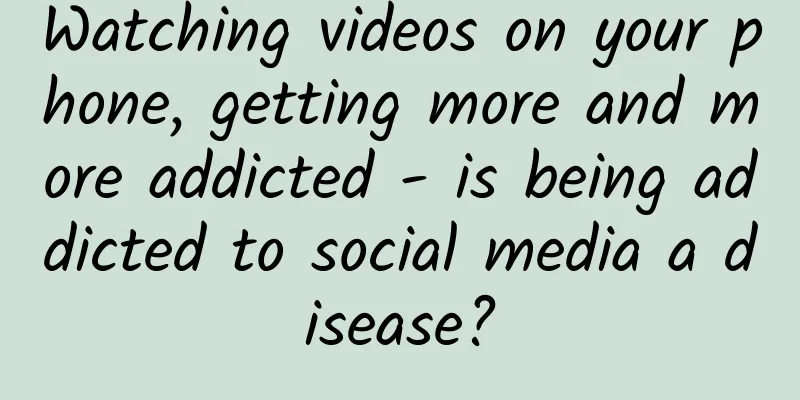Watching videos on your phone, getting more and more addicted - is being addicted to social media a disease?

|
In addition to meeting strict disease diagnostic criteria, determining "addiction" also requires support from more research. Written by | Xiaoye If you ask young people today what their favorite pastime is, many people will probably say: lying in bed and watching videos. Maybe they just wanted to relax at first, but before they knew it, they watched one video after another and couldn't stop. In recent years, short videos have emerged as a new force, and their market share has been rising steadily. There is a saying: 15 seconds on a certain audio platform is equivalent to two hours in the real world. What kind of psychological and neurological mechanisms are behind this that control our behavior? Short videos - the latest trend in social media Unlike traditional mass media, social media platforms rely on the Internet, and users can create and disseminate content, including text, images, music and videos, and exchange ideas or content with other users without being restricted by time and space. In the 21st century, social media has become the mainstream way for young people around the world to interact. The Pew Research Center's 2021 Social Media in the United States report[1] states that despite the public's overall negative attitude toward social media, 72% of Americans have used social media, a proportion that has remained fairly stable over the past five years. Among them, young people under the age of 30 are particularly keen on Instagram, Snapchat, and Tiktok, which are "short, flat, and fast" platforms that focus on pictures and videos. Among people aged 18-24, the proportion of TikTok users is as high as 55%. In my country, the latest Statistical Report on the Development of China's Internet[2] shows that as of December 2020, the total number of Internet users in my country was 989 million, with a steady growth over the past five years. Among them, the number of online video users reached 927 million, accounting for 93.7% of all Internet users. The number of short video users was 873 million, accounting for 88.3% of the total number of Internet users. The average daily usage time of short video apps is 125 minutes, 27 minutes higher than that of long videos, and the gap is increasing; 53.5% of short video users watch short video programs every day. Statistics clearly tell us that video social media, especially short videos, have become a new social site after Facebook and WeChat. Mainstream short video platforms, such as Douyin and Kuaishou, integrate "social + communication" into one. Through likes and comments below the video, users can interact within the application platform. In addition, the interconnection between various social media allows users to share the video content within the platform instantly, achieving wider dissemination. In addition, short video content often shows a unique personal style, which not only attracts the audience to feel intimacy, but also satisfies the current young people's pursuit of social experience of self-expression, further accelerating the dissemination effect [3]. The "explosive" short videos that are popular on the Internet from time to time reveal the extent to which video social media has penetrated into people's hearts. What happens in our brains when we watch videos? In this context, if we want to understand why we are easily addicted to videos, we first need to delve into our brains. What is our brain doing when we watch videos? The human brain is a very complex organ with a precise structure. The various brain regions are interconnected and interact with each other. Scientists have been working to unravel the structure and specific functions of the brain. In recent decades, functional magnetic resonance imaging (fMRI) technology has helped scientists gradually delve deeper into it, presenting brain activity more and more clearly. As early as 2010, Professor Uri Hasson's team at the Princeton Neuroscience Institute published a review article in Trends in Cognitive Sciences, pointing out an important basic phenomenon [4]: when watching videos (the materials used in this study were mainly movie clips), the brain regions that showed synchronous neural activity in response to image stimulation were almost highly consistent among different individuals, including the visual and auditory cortices, the multisensory and language areas of the temporal and parietal lobes, the anterior cingulate cortex, and many other brain regions. These brain regions are related to sensory information, attention, and emotions, indicating that watching videos can mobilize a wide range of complex and advanced cognitive functions in the human brain, and that the distribution of activated brain regions varies little between different individuals. The distribution of neural activation in different brain regions when different subjects watched different movies. Source: Not only that, the synchronized neural activity data of brain regions can also reflect or even predict the audience's preferences for videos. This setting may seem sci-fi, but it is supported by scientific research. Professor Brian Knutson's team from the Department of Psychology at Stanford University in the United States revealed this "secret activity mechanism" of the brain. In 2018, they published an article in Current Directions in Psychological Science, arguing that changes in the activity of brain regions that release dopamine may play a vital role when individuals make choices. Combining a number of previous studies, Knutson et al. discussed in detail an "emotion-integration-motivation (Emotion-Integration-Motivation (Emotion-Integration-Motivation (Emotion-Integration-Motivation (Emotion-Integration-Motivation (Emotion-Integration-Motivation (Emotion-Integration-Motivation (Emotion-Integration-Motivation (Emotion-Integration-Motivation (Emotion-Integration-Motivation (Emotion-Integration-Motivation (Emotion-Integration-Motivation (Emotion-Integration-Motivation (Emotion-Integration-Motivation (Emotion-Integration-Motivation (Emotion-Integration-Motivation (Emotion-Integration-Motivation ( Subsequently, Knutson's team conducted an experiment and published a paper in the Proceedings of the National Academy of Sciences (PNAS) in 2020 [6]. The researchers asked the subjects to undergo fMRI scans while watching videos, and found that whether people are willing to waste time watching their favorite videos is indeed determined by the brain (mainly the reward system). The scan results showed that the brain has made a decision in the first four seconds of the video: the neural activity of the nucleus accumbens and medial prefrontal cortex increased, while the neural activity of the anterior insula (AIns), which is related to processing negative emotions and risky decisions, was weakened. This state not only allows subjects to watch their favorite videos more frequently and for a longer period of time, but also can in turn predict the type of videos that the subjects like. Recently, a study from Zhejiang University in China focused on the short videos that have become popular in recent years. The results were published in NeuroImage [7]. The team invited subjects to watch generalized videos recommended to new users and personalized videos for old users. They found that when watching personalized videos, some components of the default mode network (DMN) in the brain were more active, including the bilateral superior and middle temporal gyri, temporal pole (TP), ventral posterior cingulate cortex (vPCC), medial prefrontal cortex (mPFC) and angular gyrus (AG). In addition, the ventral tegmental area (VTA) of the midbrain related to the reward system and some other discrete brain regions such as the lateral prefrontal, anterior thalamus and cerebellum also showed higher activation. Moreover, the coupling of the DMN region with the visual and auditory pathways was also enhanced, which may make people more addicted to the video by upregulating attention and higher-level perception. Dopamine, too much dopamine The brain imaging studies by the Stanford University team and the Zhejiang University team both involved brain areas related to the brain's reward system (such as the ventral tegmental area of the midbrain that synthesizes dopamine, the prefrontal cortex and nucleus accumbens that release dopamine, etc.), suggesting a relationship between dopamine and addictive video watching from a neurological perspective. Dopamine is a good thing. When we do something fun, our behavior triggers the release of dopamine from neurons in the brain, making us happier. Dopamine is mainly secreted by neurons in the ventral tegmental area and substantia nigra pars compacta (SNc) of the midbrain, and the axons of these neurons extend to other brain regions, including the nucleus accumbens, dorsal striatum (DS), and prefrontal cortex (PFC). Among them, neurons in the substantia nigra mainly encode goal-oriented behavioral choices and habit formation, and also encode information salience, making some information more likely to stand out from other noise information. At the same time, neurons in the ventral tegmental area encode the value of the reward. This process allows the brain to focus on processing the sensory information provided by the video and enhance the reward value of the video [8]. Today’s video-focused social media platforms leverage video content and carefully designed operating principles to take advantage of “behavioral reinforcement,” especially “intermittent reinforcement.” The strong anticipation of random rewards keeps people watching videos, stimulating more dopamine secretion. More than 100 years ago, Edward Lee Thorndike, an American behaviorist psychologist, proposed a learning theory called the law of effect[9], which clearly states that the process of establishing a stimulus-response connection is affected by the result of the response. If the result of the response is a reward (positive reinforcement), the strength of the connection will increase, while if the result is a punishment (negative reinforcement), the strength of the connection will decrease. Therefore, profit-seeking behaviors that lead to positive reinforcement are more likely to be repeated by the subject than behaviors that lead to negative reinforcement. At the same time, the behavior itself is constantly reshaped during the repetition process, thereby achieving positive reinforcement more directly and reliably. Neo-behaviorist psychologist Skinner and later theorists developed this theory into the "reinforcement theory." Skinner further divided reinforcement types into continuous reinforcement and intermittent reinforcement. In 2018, a paper published in the journal Science[10] proved for the first time Thorndike's law of effect from the perspective of neuronal activity patterns: reinforcement depends on dopaminergic activity in the ventral tegmental area of the brain. Animals will repeat behaviors that lead to positive reinforcement more frequently, triggering corresponding neural activity patterns in the brain, secreting more dopamine, and enjoying pleasant experiences. The same is true for swiping videos. In the video app, a variety of new videos appear in a vertical scroll. When you slide your finger up and down, you don’t know whether you will like the next video or not. This is intermittent reinforcement. After watching a video you like, if you don’t continue to swipe up and down, the video will automatically repeat, allowing you to watch it repeatedly, achieving the purpose of continuous reinforcement. In this way, repeated reinforcement, swiping videos, watching videos → stimulating the active nerves in the brain to secrete happy dopamine → continue swiping, continue watching, and a perfect reward cycle is achieved. The self-control of “losing connection” We often hear people say that they “can’t control their hands from scrolling through videos.” As early as 2012, a paper published in the journal Psychological Science studied the relationship between self-control and social media[11]. Self-control is an important line of defense against individual desires, especially when faced with various temptations and conflicts. The researchers analyzed 7,827 reports submitted by 205 adults on their own desires and conflicts, and assessed the failure rate of self-control after struggling with inner desires. The results showed that the highest failure rate was in suppressing the desire to use social media, with 42% of people’s self-control failing in the face of social media. In terms of brain neural activity, researchers have revealed the "disconnection" of self-control from the perspective of the brain's default mode network (DMN). DMN is a relatively new concept in the field of brain organization and function research. To date, the academic community believes that this network mainly plays two major functions: on the one hand, it supports internal psychological life, and on the other hand, it monitors the external environment, and the two aspects are coordinated and unified[12]. A recent study used graph theory to analyze the structural network between brain regions defined by DMN. Source: 10.1038/s42003-019-0611-3[13] According to imaging results [7], although personalized videos increased the neural activity of the previously mentioned DMN subregions, at the same time, the activity of other components of the DMN, including the ventromedial prefrontal cortex (vmPFC), dorsal anterior cingulate cortex (dACC), caudate nucleus, and part of the thalamus, was weakened, indicating that the control functions involved in these regions were inhibited. In general, the inhibition of DMN subregions allows the brain to regulate certain internal activities and optimize external cognitive functions. In addition, the coupling between three DMN nodes and the anterior cingulate cortex (ACC) and precuneus (involving cognitive control and conscious awareness) is also reduced, which may further weaken self-control and even lead to uncontrolled use. In other words, it may not be that you are born with poor self-control if you keep watching short videos, but that during the viewing process, the platform recommendation system quietly blocks the self-control function in the brain, making you "immerse" in the video without knowing it. Does obsession = addiction? Will addiction to various social media, including short videos, become an addictive behavior that is difficult to quit? A paper published in the International Journal of Environmental Research and Public Health in July this year conducted a small-scale questionnaire survey (n=20) on this issue [14]. The results showed that the subjects surveyed (average age 21.70 years old) said that their main purpose of watching videos online was social interaction, learning new knowledge, and relaxation. However, certain videos with specific content, such as pornographic content, food broadcasts, and online dramas, do make them feel addicted. In addition, the subjects specifically mentioned that the function of scrolling up and down in short videos is particularly addictive, but they feel that it is a waste of time afterwards. However, the addiction-like dependence reported by the subjects does not prove that they have confirmed addictive behavior or have symptoms of disorder, because this requires a strict clinical diagnosis of mental illness. Let’s take the example of “gaming addiction” which has been hotly discussed over the past decade or so: Currently, the authoritative fifth edition of the "Statistical Manual of Mental Disorders and Mental Disorders" (DSM-5) and the eleventh edition of the World Health Organization's "International Classification of Diseases" (ICD-11) have both included the "gaming disorder" entry. DSM-5 believes that Internet gaming disorder does have significant public health importance, but more sufficient clinical evidence is needed to list it as a formal diagnostic item[15]. On the other hand, after the World Health Organization General Assembly reviewed and approved ICD-11 in 2019, it officially included "gaming disorder" as a new disease in the "disorders caused by addictive behaviors" disease unit. And proposed the core characteristics of "gaming disorder"[16]: 1. A persistent or recurring pattern of gaming behavior characterized by uncontrollable gaming behavior, gaming becoming a priority in life, and an inability to stop despite negative consequences. 2. The gaming behavior pattern may be persistent or episodic and last for more than 12 months, but may last for less than 12 months if the symptoms are severe enough and the other diagnostic criteria are met. 3. The gaming behavior pattern results in significant impairment in personal, family, interpersonal relationships, academic, occupational, or other important areas of functioning. It can be seen that, so far, there is a certain psychological and physiological basis for social media such as short videos to make people "addicted", but whether it will develop into "addictive behavior" (i.e., addictive behavior that leads to mental disorders) is still controversial. In addition to meeting strict disease diagnostic criteria, determining "addiction" requires more scientific research support. At present, research related to short videos is still a relatively niche topic in the field of neuroscience. However, as the market share of such products continues to grow rapidly, related research is also increasing. In PubMed, searching for "tiktok" as a keyword [18], there were only 1 related articles in 2019, and 61 related articles in 2021. Among the total of 73 articles, only one involved addiction or similar addiction-related research. In addition, the Pew Research Center's 2018 "American Social Media Use" report mentioned that 59% of users said that it was not difficult for them to stop using social media, and even 29% of them said that it was not difficult to give up social media completely. In my country, according to the "Core Information and Interpretation of Chinese Youth Health Education (2018 Edition)", Internet addiction refers to the uncontrolled behavior of using the Internet without the influence of addictive substances, which manifests as excessive use of the Internet leading to obvious academic, occupational and social function damage. Among them, duration is an important criterion for diagnosing Internet addiction disorder. Generally speaking, the relevant behavior must last for at least 12 months to be diagnosed. Source: Xinhuanet [17] Is it true that being addicted to social media is all bad and no good? Since it is still unknown whether video addiction will cause lasting and irreversible damage to our brains, we can refer to some other neurological studies related to social media addiction to speculate on the possible impact of video addiction. Many previous studies have shown [19] that Internet addicts, mainly adolescents addicted to online games, have reduced gray matter volume in the prefrontal cortex. Similarly, structural changes in the left anterior and posterior cingulate cortex, insula, orbitofrontal cortex, etc. may lead to cognitive control impairment in adolescents with Internet addiction. In addition, in 2018, the journal Scientific Reports published an article on WeChat addiction and brain structural changes[20], pointing out that WeChat addiction is associated with a reduction in gray matter in the subgenual anterior cingulate cortex, which is a key monitoring and regulatory area of the neural network behind addictive behavior. In addition, a higher frequency of WeChat payment use is also negatively correlated with the volume of gray matter in the nucleus accumbens. This situation also suggests that excessive use of the Internet may damage brain health. In fact, we can all more or less feel the negative effects of long-term video watching, including emotional ones. In January this year, the International Journal of Environmental Research and Public Health published a study that surveyed 1,488 adults in Taiwan, China, with an average age of 28.3 years old[21]. The results showed that problematic binge-watching was positively correlated with an increased risk of depression, social anxiety, and loneliness. However, a study published in the journal Perspectives in Psychiatric Care in 2019[22] found through a randomized controlled trial that compared with those who continued to use social media, subjects who completely banned social media reported lower satisfaction with life, increased negative emotions, and increased loneliness. In other studies[14], respondents (7/20) admitted that social interaction during video watching gave them a pleasant sense of satisfaction. This shows that too much is as bad as too little. Excessive use of social media or excessive video watching can cause some harm, but completely banning it does not mean that it will cause completely positive changes. Faced with the siege of the social media environment, perhaps we will eventually need to watch videos scientifically and rationally. While experiencing the fun of online social interaction, we should not forget to put down our mobile phones in time and enjoy more offline time with our relatives and friends. Acknowledgements: I would like to express my sincere gratitude to Professor Ben Yang from Northwestern University for his rigorous and detailed professional comments on this article! References [1] https://www.pewresearch.org/internet/2021/04/07/social-media-use-in-2021/ [2] http://www.cac.gov.cn/2021-02/03/c_1613923423079314.htm [3] https://zjjcmspublic.oss-cn-hangzhou-zwynet-d01-a.internet.cloud.zj.gov.cn/jcms_files/jcms1/web3421/site/attach/0/e041728a26dd43fb8e483583a63cbcd9.pdf [4] https://linkinghub.elsevier.com/retrieve/pii/S1364661309002393 [5] https://journals.sagepub.com/doi/full/10.1177/0963721417737877 [6] https://www.pnas.org/content/117/12/6936 [7] https://www.sciencedirect.com/science/article/pii/S1053811921004134 [8] https://mp.weixin.qq.com/s/Lh4ZaPFvUxNOiOjJkimDww [9] https://wiki.mbalib.com/wiki/%E6%A1%91%E4%BB%A3%E5%85%8B%E7%9A%84%E8%AF%95%E8%AF%AF%E8%AF%B4 [10] https://science.sciencemag.org/content/359/6379/1024 [11] https://journals.sagepub.com/doi/abs/10.1177/0956797612437426 [12] http://blog.sciencenet.cn/blog-859583-830291.html [13] https://www.nature.com/articles/s42003-019-0611-3 [14] https://www.mdpi.com/1660-4601/18/14/7247 [15] https://www.psychiatry.org/patients-families/internet-gaming [16] http://lxjk.people.cn/n1/2019/0806/c404177-31278277.html [17] http://www.xinhuanet.com/politics/2018-09/26/c_1123487138.htm [18] https://pubmed.ncbi.nlm.nih.gov/?term=tiktok&timeline=expanded&sort=date [19] https://www.frontiersin.org/articles/10.3389/fnhum.2014.00375/full#h5 [20] https://www.nature.com/articles/s41598-018-19904-y [21] https://www.mdpi.com/1660-4601/18/3/1168 [22] https://onlinelibrary.wiley.com/doi/abs/10.1111/ppc.12431 |
<<: How to avoid lightning correctly?
>>: How do astronauts use electricity in space?
Recommend
Are fruits and vegetables tastier now than they used to be? It’s not your illusion, science proves it
When you look at the rows of brightly colored fru...
How did Keep use the "mine-laying plan" to cold start after accumulating 6 million users in 6 months?
Many products are in the early stages of promotio...
The new version of WeChat improves the video function: QQ has a new brother
WeChat has just officially released WeChat 6.3.5 ...
What changes will the body go through after pregnancy? Today, let's say "thank you" to our mothers
The annual Mother's Day is here In this warm ...
NFU Mutual: Survey shows 45% of British car owners do not consider buying electric cars in the next decade
According to foreign media reports, a new study s...
Farewell to the old era, Nokia officially changed its name to Microsoft Lumia
Nokia sold its mobile phone business to Microsoft...
What exactly is Google's Ara project?
[51CTO Translation] Modular mobile phones, which ...
Looking back at 2019: Dangerous games in the social world
01 Social Explosion At the beginning of the year,...
Vivo is a step behind: a bloated sales champion, a difficult high-end brand
The smartphone industry has always had a growth m...
June 2023 "Science" Rumor List: Is heat stroke the same as heat stroke? Can mineral water exposed to the sun in a car cause cancer?
The list of "scientific" rumors for Jun...
Haier Air Conditioning's business continues to improve in 2020, with only double growth to make up for shortcomings
After experiencing the double hardships of the pr...
Himalaya FM audio traffic promotion plan
Himalaya FM is a well-known audio sharing platfor...
In which field is it easier to make short videos? Which industries are short videos suitable for?
If you want to shoot short videos , choosing a go...
Qualcomm's opportunity to enter the server chip market
Qualcomm's business model in the mobile phone...
Why is it so bitter when you take a bite of cucumber? That's the cucumber crying for help!
Some cucumbers are very sweet when you take a bit...









